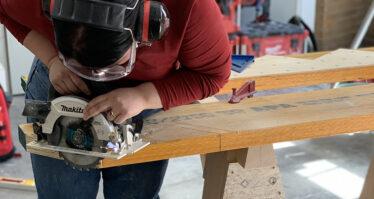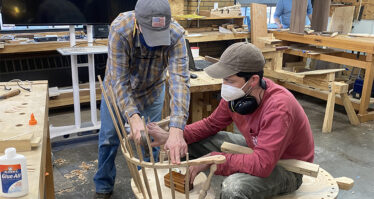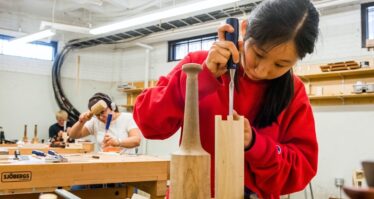Preservation Carpentry
The comprehensive Preservation Carpentry program teaches the time-honored skills and values of fine craftsmanship. Our students share a love of history, materials, quality workmanship, and working with their hands to build, restore, and preserve beautiful structures that last.
The two-year program combines an introduction to contemporary residential construction with a foundation in pre-20th century New England home construction. You’ll learn a broad range of construction methods, including stabilizing endangered buildings, preserving architectural details, and recreating historical design elements. Through lectures, hands-on projects, and collaborative field work, you’ll gain an understanding of how current technology compares to traditional techniques.
The program space includes first and second year bench rooms, where each student is assigned a bench and work space, and a central machine room. New England’s rich historical legacy of pre-20th century buildings provides exceptional field projects. Such site work is often done in collaboration with non-profit museums and historical sites.
Schedule & Curriculum
- Students are admitted in September.
- The maximum enrollment is 26 students.
- Classes meet 7:15 am – 4:00 pm, Monday – Thursday, September through May.
- The program length is two, nine-month academic years (72 weeks or 2340 class hours*).
- Students who complete the program receive a Diploma of Preservation Carpentry.
* Class hours equals clock hours.
Careers
Graduates of our Preservation Carpentry program go on to be restoration carpenters, museum conservators, owners of full-service design/build companies, and more.
Some of the notable organizations for which they’ve worked include:
- National Park Service
- The Trustees of Reservations
- Historic Charleston Foundation
- Harvard Museum of Natural History
- Historic New England
- Historic Preservation Training Center
- Mount Auburn Cemetery
- Peabody Essex Museum
More than 90% of our graduates work in related fields. However, it’s difficult to find statistical employment data for specialized trades like preservation carpentry. The U.S. Department of Labor (DOL) classifies this as Carpentry, which includes many specialized trades. Visit the DOL website to explore the general outlook for carpentry careers. Payscale reports wage data for the Historic Preservation Industry. This classification doesn’t match the description for preservation carpentry exactly, but you can use it as a general guide.
According to Payscale, the average annual salary for a construction superintendent in the historic preservation industry was $67,000 as of 2025. The median salary for an Architectural Historian is listed as $67,284 as of 2025. Comparatively, the average annual salary for carpenters was $53,718.
Job openings for preservation carpenters depend heavily on geographic location. Areas with high concentrations of historic properties will have more opportunities for preservation carpenters. Visit the National Register of Historic Places (NRHP) to see a map.
Of course, there are many more places than those listed in the NRHP that need skilled preservation carpenters. Visit the following pages to view opportunities in historic preservation:
- Job openings with The National Register of Historic Places, which are government jobs and are posted on usajobs.gov.
- Job board at the National Trust for Historic Preservation
- Employment opportunities at PreserveNet
- News and Job openings at PreservationDirectory.com
- The National Conference of State Historic Preservation Officers has links to State Historic Preservation Offices (SHPO) nationwide.
People
Faculty




Meet Our Alumni

Brent Hull PC ’93“Immediately after graduating, I was able to start my own company in Texas. We have grown into a well-respected contractor and historic millwork provider with clients across the country.”

Brahm Wilson PC ’14“When I left the [Marines] I wasn’t sure what I wanted to do, but I knew that I cared about history, the built environment, and having an active lifestyle. I chose NBSS because I wanted a program that would focus on the physical practice of historic preservation.”
Facilities
The program space includes first and second year bench rooms, where each student is assigned a bench and work space, and a central machine room. New England’s rich historical legacy of pre-20th century buildings provides exceptional field projects. Such site work is often done in collaboration with non-profit museums and historical sites.
Machine Room & 1st Year Benchroom
2nd Year Benchroom
More Info
- Preservation Carpentry program brochure: Download at-a-glance details.
- Admissions Info: How to get your application started and what you need to apply.
- Financial Aid: We’re dedicated to helping you afford the cost of your education. Learn about our financial aid options.
2023 Preservation Carpentry Graduate & Employment Report
- 7 Preservation Carpentry students started the program in November 2020 and had an intended graduation date of July 2022.
- 100% of this student cohort graduated in 2022.
- 100% of these graduates are employed in the field.
- This data was officially reported to ACCSC in October 2023.
2024 Preservation Carpentry Graduate & Employment Report
- 13 Preservation Carpentry students started the program in September 2021 and had an intended graduation date of June 2023.
- 85% of this student cohort graduated in 2023.
- 91% of these graduates are employed in the field.
- This data was officially reported to ACCSC in October 2024.
2025 Preservation Carpentry Graduate & Employment Report
- 12 Preservation Carpentry students started the program in September 2022 and had an intended graduation date of June 2024.
- 25% of this student cohort graduated in 2024.
- 50% of these graduates are employed in the field.
- This data was officially reported to ACCSC in October 2025.
This disclosure is required by our accreditors, the Accrediting Commission of Career Schools & Colleges (ACCSC).
For each of our career training programs, we consult with a group of top professionals in the field to ensure our curriculum continues to meet industry needs and trends.
The Preservation Carpentry Program Advisors are:
- Robert A. Adam
- William Lewis Barlow, IV
- Lee Noel Chase PC ’94
- Matt Diana PC ’10
- William Finch
- Anne Grady
- Brian Pfeiffer
- Denis Semprebon


